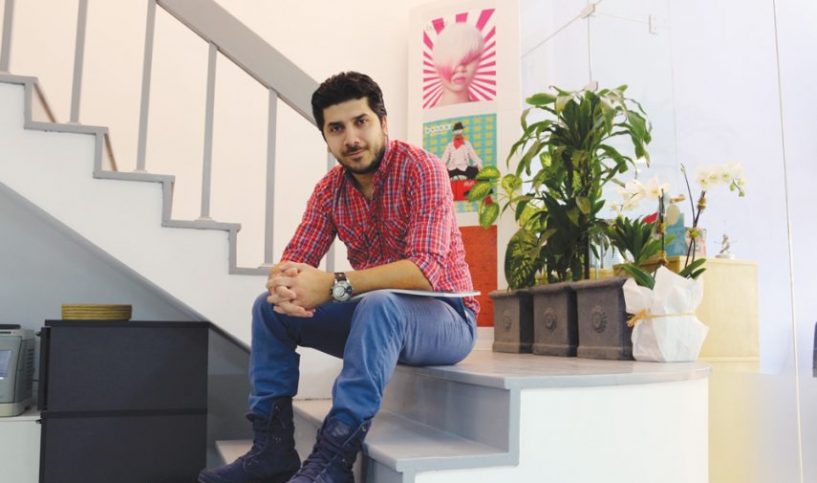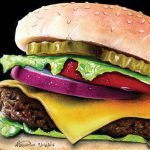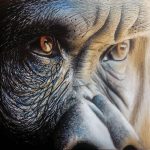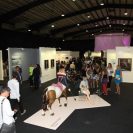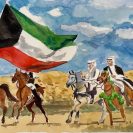Local sketch artist Hussein Baydoun values inspiration. So much that, he could spend days on end searching for the perfect subject to sketch. Once he does, however, there’s no stopping the swift, but calculated, movement of his hand across a blank canvas.
“Drawing and sketching requires a relaxed state of mind, and absolute calm. I forget everything around me—my mind is focused on the canvas in front me,” The artist began, “but I can also go for days, and at times years, without sketching if I’m feeling uninspired.”
Nonetheless, the past ten years have been full of inspiring moments for Hussein, as his hobby for realistic sketch art never left his imagination since he began dabbling with sketch drawing at the tender age of 8. He spoke further on his earlier years, “During the Gulf War, my family relocated to Lebanon but my dad still lived in Kuwait. He used to encourage me to send him my drawings in exchange for a small monetary reward, and I remember drawing an old lady crossing the street, holding a cane. I remember drawing out the shadows, and portraying the sidewalk colors—everyone said it was so advanced for my age.” Throughout his developing years, his family constantly nurtured and encouraged his talents—his mother even gifted him a clear folder album to keep his earlier works safe. While Hussein’s family believed in his talents at such a young age, Hussein didn’t realize at the time that he would be doing the exact same thing for his future daughters, Joud and Julia.
The last ten years proved to be a hard, long self-taught experience for the artist. “I utilized YouTube to learn everything I know now, “he explained, “I also owe so much to my earliest mentor during my school days, my teacher Mr. Imad. He always kept me focused on my hobby. He taught me the basic skills and tools I needed to further my talent.” Hussein cites Leonardo da Vinci’s employment of science in art as an early inspiration, teaching him how to properly research his subjects before he starts a sketch to form a plan that would successfully allow him to complete the sketch he has in mind. The famous works of the Lebanese caricaturist Stavro Jabra also resound deeply with Hussein, especially Stavro’s extremely realistic use of detail in his caricature sketches.
Hussein considers each and every sketch he works on as a challenge, whether that involves his use of colors, to medium, subject and even the type of canvas that the artists chooses to employ for each specific sketch. He said, “I look at every sketch I complete as a learning experience. This is what excites me.” From miniscule, 3-cm sized IKEA frames that inspired Hussein to stretch his sketching abilities to produce so much detail in a literal ‘mini cooper’ rendition, to oversized canvases that would take hours to complete—the artist never stops wondering who or what his next sketch would be about. Hussein is open to using any type of medium to bring his sketch work to life, “It’s like my hands take on a mind of their own. I could use pencil colors, or paint, or even coffee! Once inspiration strikes, I go with the flow and let my hands move across the canvas.”
An example that best illustrates this creative’s wonderings is a large sketch of the singer Kathem Al Saher. As a huge fan of the Kathem, Hussein is especially fascinated by the singer’s facial expressions, taking pause to capture his detailed, and absolutely emotional, facial inflections to appear on a huge canvas. Despite his realistic efforts, Hussein is also his work’s biggest critic. He looked at his sketch of the singer, and immediately spotted the mistakes. Never discouraged, Hussein is eager to sketch again to further his talents and correct his mistakes. He sees his style as continuously evolving and improving, and considers practice as the most important factor that allows him to grow his skills as an artist. The same could be said about all of his work, whether he focuses his efforts on creating incredibly realistic renditions of animals, or other people he deeply admires like Lebanese legend and singer Wadi Al Safi.
With many past appearances in local news outlets, the notion of fame might seem tempting. Yet, Hussein’s family play a huge role in developing his personal goals as an artist. He told bazaar that “As much as gaining recognition could excite me, I consider my daughter Joud’s emerging love for drawing as more important. I see myself in her drawings. I hang up all of my work around the house to surround her and my family with art and to inspire her to express herself through art.” At almost 6 years old, Joud is already showing promising talent, and Hussein is eager to teach her the basic skills he also acquired at such a young age. Family is paramount to the artist, and he cites his daughters Joud and Julia as his constant reminder to keep sketching, and when he’s feeling uninspired—he looks to young Joud’s budding ambition, and the urge to sketch returns.
While he dabbled with caricature art in the past, Hussein favors creating realistic sketches, as he loves capturing his subject’s in the most real possible manner, even with faults and all.
“I never aim to beautify my subjects. I just want to portray what I view.”
Sketching comes so naturally to Hussein, that once the inspiration strikes, nothing can stop him. His sketching rituals involve him plugging in his headphones and working away at a canvas while listening to the music that he loves. He enjoys the soothing sounds of Fairuz, Kathem Al Saher, and Lebanese singer Wael Kfoury and loses himself completely to the work in progress.
His creative bubble, once created, cannot be interrupted—except for his daughter Joud. “Once, Joud approached me, asking me how to draw a perfect circle. I explained to her the various methods, from using the protractor, to finding a jar or circular shape to trace around. We drew the circle, then went outside to our garden, and she looked up to the sky, then asked me to draw her a picture of a round moon. As simplistic as that sounded, it took me six hours to complete the moon sketch. Her questions, her curiosity, and her sense of amazement by art truly drive me to continue with my sketch work.”
In looking to the future, Hussein not only wishes to share his art with family, but with the world. He hopes to teach other young students, just like his daughter Joud, about the special connection he has with his sketch pad. How, in what feels like mere moments, hours could pass as he pours his emotions on to a blank canvas, only to have it transformed at the end into a magnificent piece of art.
For more information about Hussein Baydoun, please follow the artist’s work on Instagram: @hassoonation_art.

